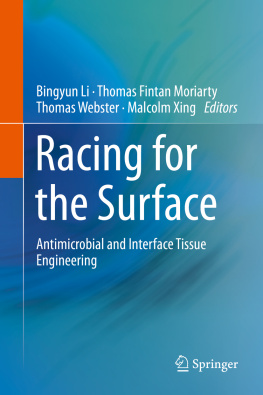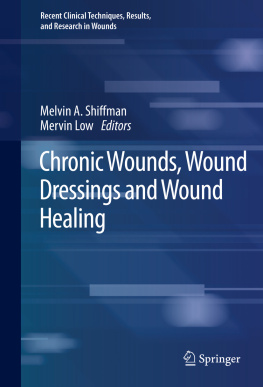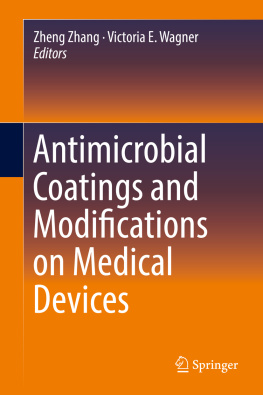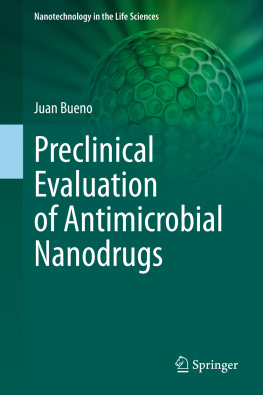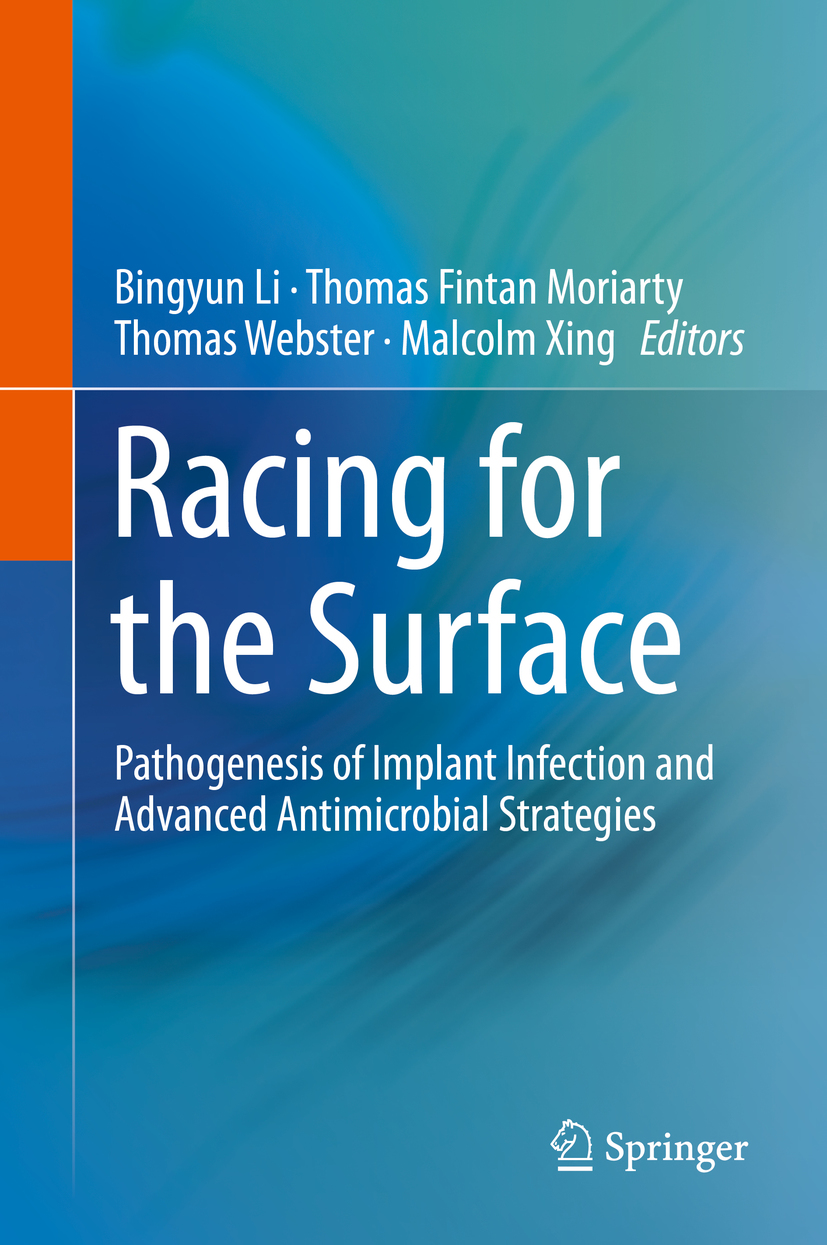Editors
Bingyun Li
Department of Orthopaedics, West Virginia University, Morgantown, WV, USA
Thomas Fintan Moriarty
Microbiology Lab, AO Research Institute Davos, Davos Platz, GR, Switzerland
Thomas Webster
Department of Chemical Engineering, Northeastern University, Boston, MA, USA
Malcolm Xing
Engineering and Medicine, University of Manitoba, Winnipeg, MB, Canada
ISBN 978-3-030-34474-0 e-ISBN 978-3-030-34475-7
https://doi.org/10.1007/978-3-030-34475-7
Springer Nature Switzerland AG 2020
This work is subject to copyright. All rights are reserved by the Publisher, whether the whole or part of the material is concerned, specifically the rights of translation, reprinting, reuse of illustrations, recitation, broadcasting, reproduction on microfilms or in any other physical way, and transmission or information storage and retrieval, electronic adaptation, computer software, or by similar or dissimilar methodology now known or hereafter developed.
The use of general descriptive names, registered names, trademarks, service marks, etc. in this publication does not imply, even in the absence of a specific statement, that such names are exempt from the relevant protective laws and regulations and therefore free for general use.
The publisher, the authors, and the editors are safe to assume that the advice and information in this book are believed to be true and accurate at the date of publication. Neither the publisher nor the authors or the editors give a warranty, expressed or implied, with respect to the material contained herein or for any errors or omissions that may have been made. The publisher remains neutral with regard to jurisdictional claims in published maps and institutional affiliations.
This Springer imprint is published by the registered company Springer Nature Switzerland AG
The registered company address is: Gewerbestrasse 11, 6330 Cham, Switzerland
Foreword
With the implantation of new devices and novel technologies to mitigate pain and improve function, unforeseen, sometimes serious complications are currently being observed that may limit the lifetime of the implant. In orthopedic surgery, chief amongst these adverse events is implant infection. Whether the implant is a permanent prosthesis (such as in joint replacement or a spinal device), or a biodegradable polymeric device (e.g., for fracture fixation or reconstruction of deficient ligaments), acute and chronic infection can occur. Infection of an implant induces local inflammation, subsequent pain and poor function, and may necessitate removal of the implant, aggressive debridement of the local tissues, and prolonged antibiotic treatment. Infections of orthopedic implants are a substantial burden to society and the healthcare system and a devastating financial and psychosocial event in the lives of patients and their families.
Are orthopedic implant infections common? In joint replacement surgery of the lower extremity, periprosthetic infection is the leading cause of failure of total knee replacements and is amongst the top three reasons for failure of total hip replacements. Given the fact that joint replacement of the hip and knee total more than one million cases per year in the USA alone, and the infection rate varies from about 0.5 to 10% or more depending on the complexity of the case, implant infection is a potential scenario that cannot be ignored. Substantial clinical and basic research has been performed to identify the causative organisms and provide antiseptics and antibiotics to accompany radical surgical debridement, and if necessary, implant removal. However, these secondary measures do not address the major challenge in this area, namely how to prevent the occurrence of infection primarily and in the longer term. These issues have great relevance to clinical practice. The population is aging and individuals want to remain active at all ages including in their later years of life. At the same time, the immune system ages, making the elderly more susceptible to infection, compared to younger individuals. Furthermore, advances in the treatment of chronic diseases such as diabetes, cancer, and others are enabling individuals to enjoy an extended life span despite a compromised and aging immune system. The possibility of late infection of an implant looms over these individuals because of their suboptimal immune status.
Thus, there are major challenges that present themselves to orthopedic clinicians, researchers, device manufacturers, government regulators, insurance companies, and other related parties. These challenges pertain to the selection and optimization of patients who will be receiving orthopedic implants, the appropriate use of peri-operative antibiotic prophylaxis, implant choice and surgical technique, and postoperative care to improve patient outcomes. Surgical devices need to have an established track record of safety, efficacy, and cost-effectiveness, and be relatively straightforward for the surgeon to implant. Recent studies have demonstrated that the properties of the device including its composition, shape, topography, and surface properties, as well as the addition of specialized treatments and coatings may have a major impact on the development of implant infection. In this regard, the compendium of chapters in this book on current developments in the field of orthopedic implant infection is both timely and indispensable to the broadening of our knowledge base on a subject that continues to plague orthopedic surgeons and patients alike.
Stuart Goodman
June 2, 2019
Preface
Medical Device Infections: Is Anyone Paying Attention?
Infection is a problem that has always (and consistently) been an issue for medical devices, and understandably so. Whenever a medical device is surgically inserted into the body, an open wound to the environment creates an ideal opportunity for numerous and diverse microorganisms to penetrate and grow uncontrollably on exposed tissue and on an implant. While your tissues have the ability to at least partially fight such bacteria presence, todays orthopedic implants do not. As if this was not cause for alarm alone, consider that no matter how sterile and clean a surgical room is, thepatientcarries a significant number of bacteria with them to surgeryit is on ourownskin.
From the start, it appears to be a losing battle to keep bacteria from infecting surgical wounds and colonizing implants. But at one time, therewashope: antibiotics. Please make no mistake about it. Antibiotics have significantly helped patients and reduced or eliminated infection in millions of patients worldwide. But times have changed. As is now well documented and agreed upon in the medical community, bacteria can quickly mutate around antibiotics to render them useless. Antibiotics are not the solution anymore, and this has led to startling statistics.
As just one example, the U.S. Centers for Disease Control has predicted more deaths from antibiotic-resistant bacteria than all cancers combined by 2050. Think about this. If this doesnt get your attention, I am not sure anything will. More deaths from bacteria than


